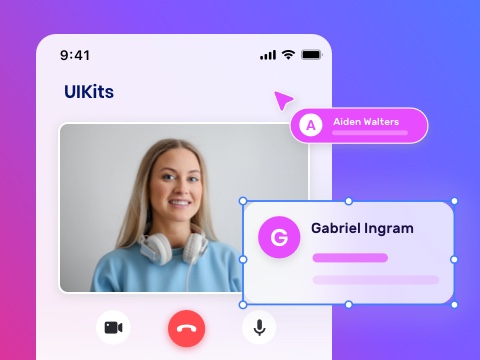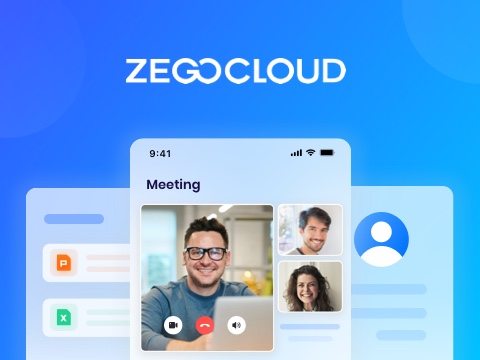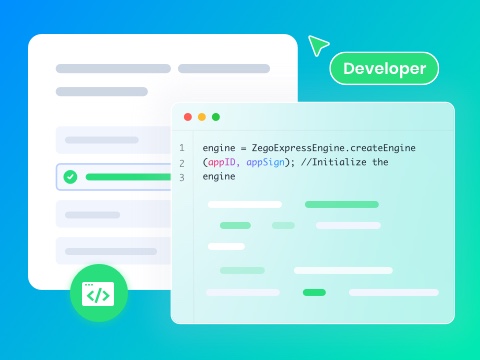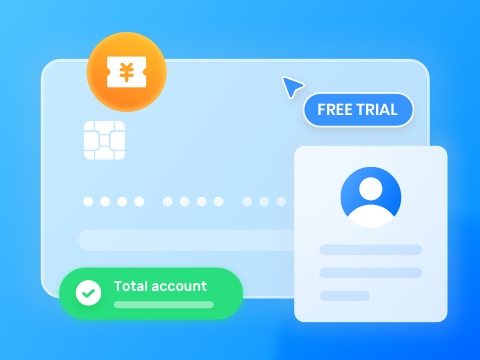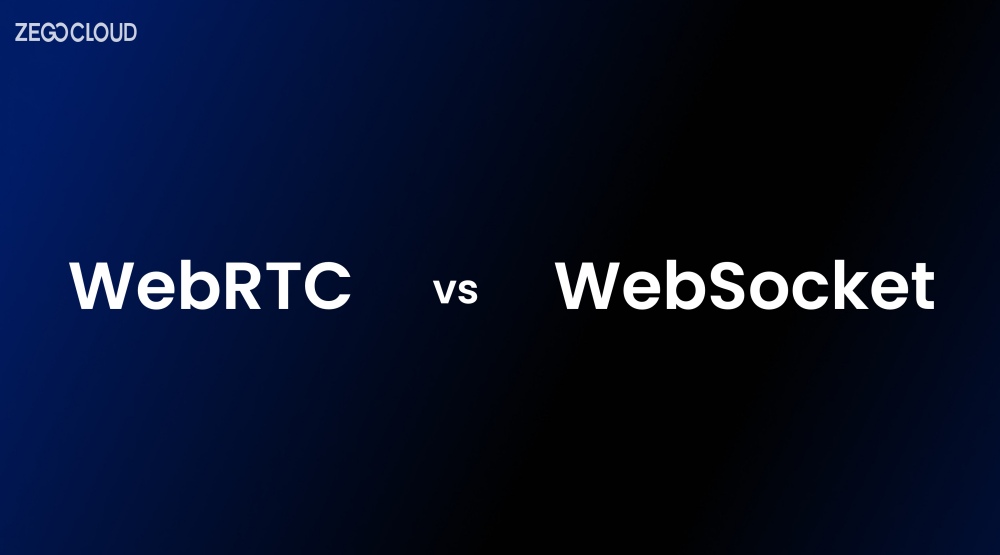WebRTC and WebSocket are two essential technologies in real-time web communication, each suited to different needs. While both enable live interaction, understanding WebRTC vs WebSocket differences is key to choosing the right solution. This comparison explores their core functions, benefits, and ideal use cases to help developers make informed decisions for web projects.
What is WebRTC?
WebRTC, or Web Real-Time Communication, is an open-source project and technology standard that enables direct, peer-to-peer communication between web browsers and mobile applications via simple APIs. It supports real-time video, audio, and data transfers without the need for plugins or third-party software. This technology is designed to work across different platforms and browsers, facilitating seamless communication experiences directly within web pages.
WebRTC enables a wide range of applications, such as video and voice conferencing, live streaming, file sharing, and real-time gaming, by providing built-in capabilities for accessing device cameras and microphones, encrypting data, and managing network connectivity. Its main components include:
- MediaStream: Captures audio and video streams.
- RTCPeerConnection: Establishes the connection between two peers for audio and video communication.
- RTCDataChannel: Allows bidirectional data exchange between peers.
Leveraging the power of WebRTC, ZEGOCLOUD offers developers an easy-to-integrate SDK that simplifies the process of incorporating real-time communication features into their applications. By handling the complexities of WebRTC infrastructure, ZEGOCLOUD enables developers to focus on creating engaging user experiences with high-quality video and audio calls, live streaming capabilities, and more, all while ensuring secure and scalable communication across any device and network.

Pros and Cons of WebRTC
WebRTC is a free, open-source technology that allows real-time communication between two or more devices over the Internet. It can be used for video calls, voice calls, and file sharing.
Pros of WebRTC
- Easy to use: WebRTC is a relatively easy technology to use. Many libraries and frameworks are available that make it simple to integrate into web applications.
- Secure: WebRTC uses end-to-end encryption to protect the privacy of your data. The message is private and can only be seen by the sender and receiver.
- Platform-independent: WebRTC works on all major browsers and platforms, including Chrome, Firefox, Edge, and Safari.
- Low latency: WebRTC has low latency, meaning there is a short delay between when you send a message and when the other person receives it. This makes it ideal for real-time applications such as video calls and voice calls.
- Bandwidth-efficient: WebRTC is bandwidth-efficient, which means it can work well even on slow internet connections.
- Read more: if you want to go deeper on the topic, here is a deep dive into What is Network Bandwidth?
Cons of WebRTC
- Not yet widely adopted: WebRTC is still a relatively new technology, and it has yet to be widely adopted by all browsers and platforms. This can make it difficult to find applications that use WebRTC.
- Can be complex to implement: Despite the benefits, WebRTC can be tough to implement, especially for more advanced features such as group calling and file sharing.
- Can be CPU-intensive: WebRTC can be CPU-intensive, especially for high-quality video calls. This can make it challenging to run WebRTC applications on devices with limited processing power.
How Does WebRTC Work?
WebRTC lets web browsers talk directly to each other. The browsers connect without going through a server. This makes the connection faster. Below is a simple demonstration of how WebRTC works:
Firstly, WebRTC uses STUN to help browsers find their public IP addresses. This works even if the browsers are behind a router using NAT. NAT lets multiple devices share one public IP address.
Secondly, Once the browsers know their public IP addresses, they use ICE to figure out how to connect to each other. ICE tries different ways to connect the browsers directly. It can also use TURN servers or STUN servers if needed.
Finally, After the browsers connect, they can start sending audio and video to each other. The data is encrypted using SRTP to keep it secure. This allows the browsers to transmit media reliably.
What is WebSocket?
WebSocket provides real-time communication between a client and a server. It creates a continuous, two-way connection instead of the request-response pattern used in HTTP. This allows for instant data flow without the client having to ask for it. WebSocket is useful for chat, gaming, and trading apps that require constant updates.
In addition, WebSocket connects faster than HTTP. It has less overhead because it does not need all the headers and cookies required in HTTP requests. Once the WebSocket link is made, the client and server can exchange data freely. They do not need to open and close multiple connections.
Overall, WebSocket is a major step forward for real-time apps. Its persistent connections provide constant streams of data with low overhead. The two-way messaging and flexibility offered by WebSocket make it ideal for modern web development needs.
Pros and Cons of WebSocket
WebSocket is a great technology, but it has some limitations. Let’s take a look at the pros and cons of WebSocket in this section.
WebSocket Pros
- Real-time communication: To begin with, WebSockets allow two-way communication between the client and server in real-time. This makes WebSockets well-suited for apps that need to send data back and forth instantly, like chat, multiplayer games, and stock trading platforms.
- Low latency: Moreover, WebSockets have very low latency, which means that data is transferred quickly between the client and the server. Hence, it’s vital for applications that require fast updates, such as online gaming.
- Efficient bandwidth usage: WebSockets only use a small amount of bandwidth, which is important for applications that are used over mobile networks or other limited bandwidth connections.
WebSocket Cons
- Not supported by all browsers: While WebSockets are supported by most major browsers, there are a few that do not yet support them. This can be a problem if you need to support a wide range of browsers.
- Can be complex to implement: Furthermore, WebSockets can be more complex to implement than other communication protocols, such as HTTP. This is because they require both the client and the server to be able to understand the WebSocket protocol.
- Can be susceptible to abuse: Lastly, WebSockets can be used to send large amounts of data, which can be abused by malicious users. This is why it is important to implement security measures to protect against abuse.
How WebSocket Works
WebSockets make a connection between a client and a server that stays open. This open connection lets the client and server talk to each other in real-time without needing to make a new connection every time.
The WebSocket connection starts with an HTTP handshake. The client sends a request to the server asking to “Upgrade” to WebSockets. The server sends back a response that also agrees to “Upgrade” to WebSockets. This back-and-forth sets up the WebSocket connection.
Once the WebSocket connection is set up, the client and server can send messages to each other. The messages can be text or binary data. They use the same protocol as HTTP but without the limits. For example, WebSocket messages can be bigger than 1024 bytes. Also, one side can send a message without waiting for a reply from the other side.
The open WebSocket connection lets the client and server exchange messages freely in real-time. They don’t need to keep making new connections for each message.
Differences Between WebRTC and Websockets
WebRTC and WebSockets are two ways for computers to talk to each other in real time. With WebRTC, the computers talk directly to each other. This works well for things like video calling where you want it to be fast. But WebRTC is hard to set up and not all browsers support it.
With WebSockets, the computers talk through a server in the middle. This works better for things like chat where you want it to be reliable. But it can be slower than WebRTC.
The table below summarizes the differences between WebRTC and WebSockets:
| Feature | WebRTC | WebSockets |
| Transport protocol | Uses UDP | Uses TCP |
| Connection type | Peer-to-peer | Client-server |
| Real-time communication | Supports | Supports |
| Latency | Lower | Higher |
| Bandwidth usage | Lower | Higher |
| Security | More secure | Less secure |
| Browser support | Most browsers | All major browsers |
| Complexity | More complex | Less complex |
| Use cases | Video calling, live streaming, file sharing | Real-time chat, stock trading, gaming |
So if you need things to be fast, use WebRTC. If you need a more reliable connection, use WebSockets. You have to think about what is more important for your app.
You may also like: XMPP vs WebSocket: How to Choose for Chat App?
When to Use WebRTC?
WebRTC is particularly well-suited for scenarios that require direct, peer-to-peer communication with high-quality audio and video streaming capabilities. Here are some specific use cases where WebRTC shines:
- Video and Audio Conferencing: WebRTC enables real-time video and audio calls directly within web browsers without the need for additional plugins or software, making it ideal for virtual meetings, webinars, and conferences.
- Live Streaming: Although WebRTC is designed for peer-to-peer communication, it can be adapted for one-to-many broadcasting scenarios, such as live streaming events, where low latency is critical.
- Real-time Gaming: WebRTC’s low latency communication is perfect for online gaming that requires real-time interaction between players.
- File Sharing: WebRTC allows for the direct transfer of files between users in a peer-to-peer fashion, ensuring quick and secure sharing without relying on intermediary servers.
- Chat Applications: Beyond video and audio, WebRTC supports data channels, enabling real-time text chat and the exchange of other data types directly between users.
- Telehealth: For telemedicine applications, WebRTC offers a secure and private way for patients to communicate with healthcare providers via video consultations.
- Education and E-Learning: WebRTC facilitates interactive online learning experiences, including live classes, tutoring sessions, and collaborative projects.
Whenever your application demands secure, high-quality, and real-time communication capabilities without the complexity of installing dedicated software or plugins, WebRTC is an excellent choice. Its ability to work across different platforms and browsers also makes it highly versatile for a wide range of web-based communication solutions.
When to Use WebSockets?
Use WebSockets when you need full-duplex communication between a client and a server over a long-lived connection. This is ideal for scenarios where you want to push updates from the server to the client in real-time, such as in:
- Chat Applications: Instant messaging where messages need to be exchanged in real-time between users.
- Live Notifications: Updating users with live notifications, such as new posts or social media interactions.
- Online Multiplayer Games: Games requiring constant data exchange between players and the server.
- Financial Applications: Displaying live trading, stock market data, or other financial transactions that require real-time updates.
- Interactive Dashboards: Real-time updating of user interfaces, such as dashboards with streaming data, live stats, or monitoring systems.
WebSockets provide an efficient, persistent connection for ongoing data exchange, making them suitable for applications where latency and real-time updates are critical.
When to Use WebRTC Together with WebSocket?
Using WebRTC together with WebSocket is ideal for applications needing both peer-to-peer and server-client communication.
WebRTC excels in direct audio, video, and data exchange, making it perfect for real-time interactions. However, it requires a signaling mechanism to initiate these connections, which is where WebSocket comes in. WebSocket facilitates the initial handshake between peers using a server, after which WebRTC takes over for direct communication.
This combination is particularly useful in complex applications like video conferencing, live streaming with chat, or multiplayer gaming, where you need both efficient, real-time peer connections and a reliable way to coordinate these connections or exchange ancillary data via a server. Combining WebRTC with WebSocket ensures robust connectivity, scalability, and enhanced functionality in modern web applications.
WebRTC vs WebSocket: How ZEGOCLOUD Enhances Real-Time Solutions
When deciding between WebRTC and WebSocket for your real-time application, integrating a powerful platform like ZEGOCLOUD can simplify the development process and enhance the performance of either technology.
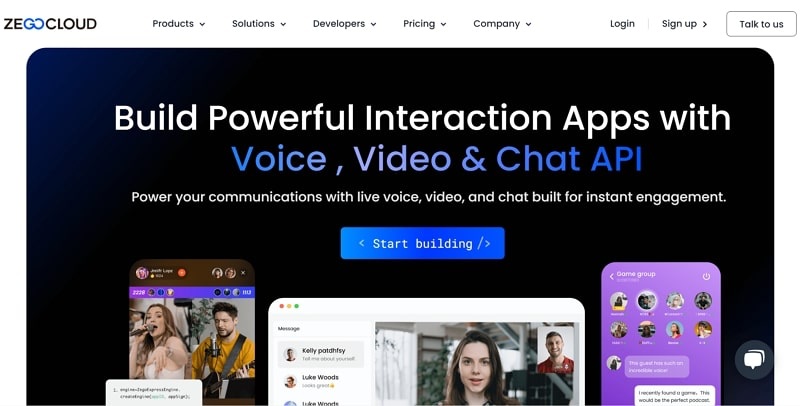
If you’re building applications that require low-latency, peer-to-peer communication—such as live video streaming or video conferencing—ZEGOCLOUD’s WebRTC-powered solutions offer seamless implementation. Their technology ensures high-quality and reliable connections, making it easier to deliver smooth and immersive experiences to users.
For applications that rely on server-based messaging or real-time updates, ZEGOCLOUD’s support for WebSocket integration provides a robust foundation. It ensures efficient and scalable communication, ideal for scenarios like live chat or collaborative tools.
By leveraging ZEGOCLOUD’s expertise and comprehensive SDKs, developers can focus on creating exceptional user experiences while relying on a trusted partner to handle the technical complexities of real-time communication.
Conclusion
WebRTC and WebSocket are useful real-time technologies, but each has different pros. WebRTC is best for direct streaming between peers. WebSocket is better for reliable chat-style messaging. Look at what matters most for your app. For one toolkit with both, ZEGOCLOUD SDK supports WebRTC and WebSocket. This lets you make many kinds of real-time apps easily. With the right tech pick, you can build great apps people love. Sign up to get started!
Read more:
WebRTC vs WebSocket FAQs
Q1: Is WebRTC better than WebSockets?
WebRTC and WebSockets serve different purposes, so one isn’t inherently “better” than the other. WebRTC is designed for real-time peer-to-peer communication, ideal for audio, video streaming, and file sharing. WebSockets, on the other hand, are best for low-latency, bidirectional communication, such as chat applications or real-time notifications. The choice depends on your specific use case.
Q2: What is faster than WebSocket?
For most applications, WebSockets offer very low latency and are highly efficient. However, in specific scenarios like peer-to-peer communication, WebRTC can be faster because it avoids server relays and establishes direct connections, reducing transmission delays.
Q3: Is there anything better than WebSocket?
“Better” depends on the application. For peer-to-peer, real-time communication like video calls, WebRTC is more suitable. For simpler, server-based communication like live updates or messaging, WebSockets are often the best choice. Other technologies like MQTT or SSE (Server-Sent Events) might be better alternatives for certain lightweight or broadcast scenarios.
Q4: Is WebSocket good for video streaming?
WebSockets can be used for video streaming but are not ideal for high-quality or real-time requirements. They lack built-in support for media encoding or low-latency transmission optimization, which makes WebRTC a much better choice for video streaming, especially in live or interactive applications.
Let’s Build APP Together
Start building with real-time video, voice & chat SDK for apps today!


